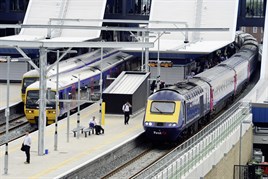The only interruptions to the space are the lift shafts to each platform. This capacity is mirrored by the main exit, which has four escalators plus flights of stairs of equal width. These lead you down to a new concourse with more than a dozen ticket gates, that let you out onto the redeveloped square outside the 1860s station building.
Walking through this area (which is still a bit of a building site), I re-enter the station via the older 1989 building.
Although much quieter now that its primary role has been lost, the building is still the main retail area and ticket hall for the station. It also serves as the main entrance for the electrified Eastern bays used by both First Great Western services to Gatwick and South West Trains services to Waterloo.
The platforms have been lengthened (and a new one added), resurfaced and fitted with new canopies. The same is not yet true for Platform 4 and the Western bays - although the old canopies have mostly been stripped away, the area is a tangle of old stanchions, temporary ‘Heras’ fencing and new steelwork. But the gain will be worth the pain.
Heading back over the transfer deck, I explore the entirely new Northern entrance to the station, reached by the longest escalators on the site. They feel massive!
At the bottom is a new ticket office that will serve the 30% of passengers who are expected to use this way into the station, saving five to six minutes for travellers from the north of Reading. To facilitate this, a bus terminal and taxi rank has been established right outside the entrance.
It is only when I stroll up to the top deck of the nearby car park, to gaze across the station and Eastern approaches, that the scale of the redevelopment became clear. There is precious little that I recognise, apart from the old clock tower.
The approaches are a sea of fresh ballast, tracks and signals, while the cess is pockmarked with bases for overhead line equipment. If ever there is clear evidence of the level of investment going into our railways, Reading provides it.
Reading is in for further exciting times, as electrification transforms Great Western Main Line services between 2014 and 2016.
The venerable HSTs will (mostly) be replaced by IEPs, and Thames Turbos by refurbished Class 319 EMUs. Although Crossrail is only programmed to run as far as Maidenhead, it can surely only be a matter of time before it’s extended to Reading.
From humble beginnings Reading is fast becoming a jewel in the railway networks crown. I wonder what Brunel, the station’s original creator, would have made of all this?















Login to comment
Comments
No comments have been made yet.